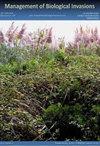Management of invasive, plague-carrying signal crayfish by physical exclusion barriers
IF 1.5
4区 环境科学与生态学
Q3 BIODIVERSITY CONSERVATION
引用次数: 0
Abstract
Invasive, plague-carrying signal crayfish represent a significant threat to imperiled European crayfishes. In the absence of a feasible eradication technique, physical barriers that separate invasive from native crayfish populations have been suggested as management strategy. Here, we investigated the effectiveness of three serial barriers with different functionality (flow-based vs . waterfall-based) in a headwater stream in southwestern Germany on containment of signal crayfish and crayfish plague. Crayfish distribution was surveyed three and six years after the construction of the barriers using manual search, trapping, and eDNA detection, whereby a tributary stream without barriers served as a form of control for a “do-nothing” scenario. The efficacy of the barriers was also empirically assessed by stocking marked crayfish downstream of the barriers and tracking their nocturnal behavior. After six years, native crayfish were still present upstream of the barriers but went extinct in the control stream due to signal crayfish invasion. Following two years of extreme drought after the first survey, signal crayfish were able to overcome the flow-based barrier but were never detected upstream of the waterfall-based barriers. Overall, this case study provides evidence for the effectiveness of intentional stream fragmentation as management strategy against invasive aquatic species.通过物理隔离屏障管理侵入性、携带鼠疫信号的小龙虾
入侵的、携带瘟疫信号的小龙虾对濒危的欧洲小龙虾构成了重大威胁。在缺乏可行的根除技术的情况下,将入侵小龙虾种群与本地小龙虾种群分开的物理屏障已被建议作为管理策略。在这里,我们研究了三种具有不同功能的系列障碍的有效性(基于流vs .基于流)。在德国西南部的一条源头河流中发现了小龙虾和小龙虾瘟疫。在设置屏障3年和6年后,研究人员使用人工搜索、诱捕和eDNA检测对小龙虾的分布进行了调查,在这种情况下,没有屏障的支流溪流作为“无所作为”情景的一种控制形式。通过在屏障下游放养有标记的小龙虾并跟踪其夜间行为,对屏障的效果进行了实证评估。6年后,本地小龙虾仍在屏障上游存在,但由于信号小龙虾入侵,在控制流中灭绝。在第一次调查之后,经历了两年的极度干旱,信号小龙虾能够克服以流动为基础的屏障,但从未在瀑布为基础的屏障上游被发现。总的来说,本案例研究为有意识的溪流破碎化作为对抗入侵水生物种的管理策略的有效性提供了证据。
本文章由计算机程序翻译,如有差异,请以英文原文为准。
求助全文
约1分钟内获得全文
求助全文
来源期刊

Management of Biological Invasions
Agricultural and Biological Sciences-Ecology, Evolution, Behavior and Systematics
CiteScore
3.40
自引率
6.70%
发文量
21
审稿时长
16 weeks
期刊介绍:
Management of Biological Invasions, established in 2010 by Dr. Elias Dana, is an open access, peer-reviewed international journal focusing on applied research in biological invasions in aquatic and terrestrial ecosystems from around the world. This journal is devoted to bridging the gap between scientific research and the use of science in decision-making, regulation and management in the area of invasive species introduction and biodiversity conservation.
Managing biological invasions is a crisis science, with Management of Biological Invasions aiming to provide insights to the issues, to document new forms of detection, measurements and analysis, and to document tangible solutions to this problem.
In addition to original research on applied issues, Management of Biological Invasions publishes technical reports on new management technologies of invasive species and also the proceedings of relevant international meetings. As a platform to encourage informed discussion on matters of national and international importance, we publish viewpoint papers that highlight emerging issues, showcase initiatives, and present opinions of leading researchers.
 求助内容:
求助内容: 应助结果提醒方式:
应助结果提醒方式:


